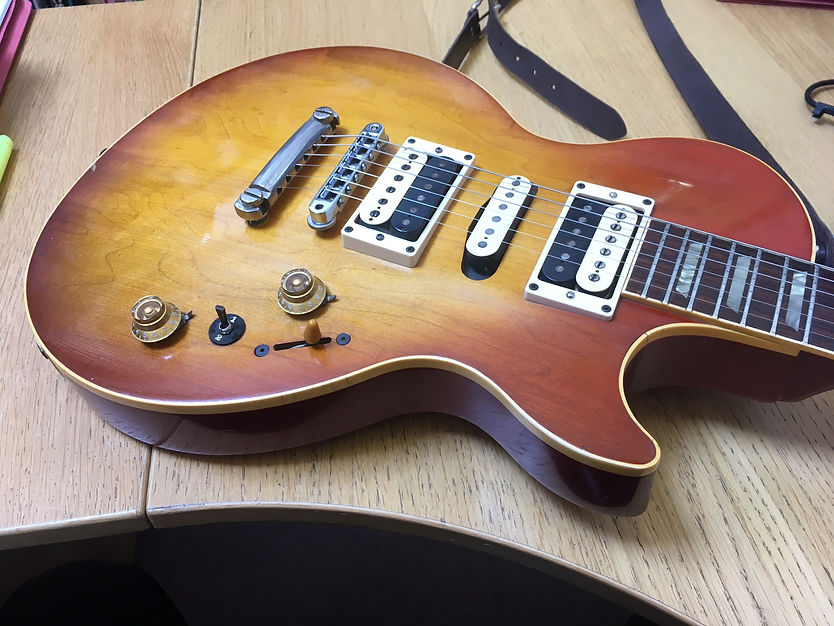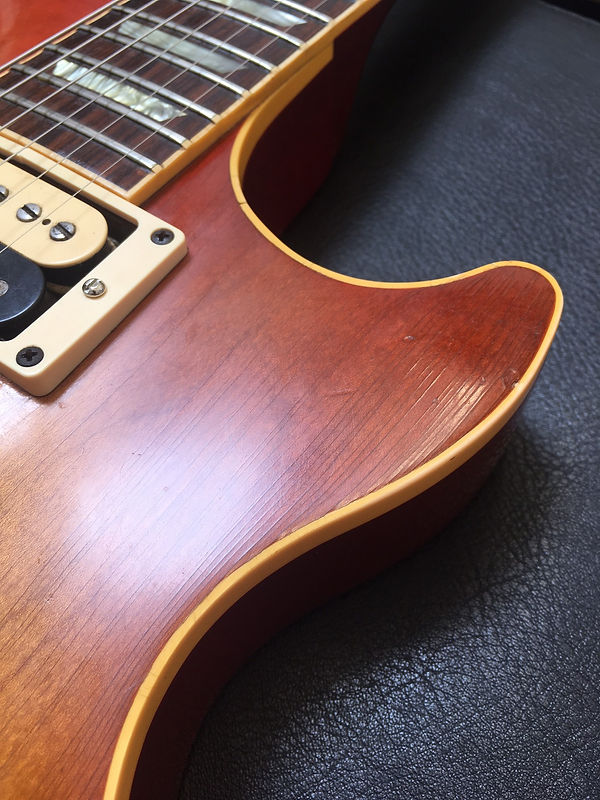DoctorPaul's Guitar Emporium - Sold Guitars

1991 Gibson Les Paul Classic M-iii (M3)
"Billy"
# 1-5735
My early '90s fascination with guitars was a great initiation to the guitar-addiction that followed, but unfortunately occurred when my eyes were significantly bigger than my wallet. Back in those days I kept a scrap-book full of adverts and clippings of gear that I lusted after, and would surely (some day) eventually own. At least that was the plan. Back in those days, I had to save up to buy strings, let alone new guitars.
Among those clippings were (of course) Les Pauls, as well as the obligatory Charvels, Jacksons and other quite niche '80s gear. No Strats though. Nuh-huh ... I hated Strats.
Now, bearing in mind that I didn't get my first Les Paul until early 2000, at the top of my 'want' list was the Gibson Les Paul Classic, and it had to be cherry sunburst. Back in those days the Classic was structurally identical to the Standard, save for the thin, '60s profile neck. Other differences were limited to the hotter pickups with exposed black bobbins, 'Classic' on the headstock silk-screen instead of the usual 'Model', aged board inlays and 'Classic' on the truss rod cover. Oh, and '1960' stamped into the pickguard. That guitar was on the cover of a guitar buyer's guide that I read cover-to-cover relentlessly back in the day (I still have it). I wanted one, and I wanted one BAD.
On my want list was also the Gibson M-iii (M3 to its buddies). That guitar was a bit of an enigma. It was all Gibson (mahogany, set neck, pearl logo) but was a streamlined stratesque shape with a reverse Explorer headstock and a Gibson-branded Schaller Floyd. They were part of Gibson's attempt to break into the superstrat market; something that they've consistently failed to do. Although most of them had a (horrendous) tortoise-shell pickguard, their selling point was a set of fancy electronics (pretty advanced for the time) that drove an HSH pickup layout. The pups were controlled by a five-way and a two-way, which offered all kinds of tonal tomfoolery. Original models were (and are) pretty rare, as they didn't sell that well. These days, they pop up for sale now and then, but the Floyds were pretty fragile, and the ones that I've seen over the last decade or so have all had the same (fatal) Floyd issue. Fixing the problem would mean a new base-plate, and as the originals were Gibson-branded, you're pretty much guaranteed never to find a kosher replacement. On that basis, I've passed on every M3 that I've ever seen for sale.
Although I was blissfully unaware at the time, the timing of the original M3 release coincided with Gibson's original Les Paul Classics. And what do you know, it turns out that they were crazy enough to jumble the two designs together. I see the process as having been some bizarre late-night interbreeding experiment, where a nice Les Paul and an M3 were given large amounts of tequila, then someone turned down the lights, lit a scented candle and put on a Barry White CD. The result was a proper old-school Les Paul Classic, but with a complete set of M3 pickups and electronics. Like this one.
Whether the Les Paul M3 was an inspired juxtaposition of two great designs, or was just a disgusting abomination, is a matter of debate. What is for certain is that the purist Les Paul cork-sniffers HATED them. That's their choice, and I understand and appreciate that the obvious departure from the lovely purity of a 'normal' Les Paul is a little jarring at first, at least visually. Certainly, if I had just one Les Paul, I'd want it to look exactly like a Les Paul should, and this certainly doesn't. Pick it up, however, and those concerns over the visuals disappear instantly ... this is a genuinely fantastic guitar to play, and is ALL Les Paul.
I've not found any information regarding how many were made, but I understand that Gibson never released any marketing material to support these (not even a flier or a press release); Gibson dealers each simply got a fax to tell them that these existed. I've looked ... hard ... and have found evidence of six of them, including this one (and this one is the only one that I've ever seen in the flesh). So, they would appear to be really quite rare birds. Of course, as I've said before, rarity doesn't make guitars GOOD, but it makes me smile to have rare stuff on the racks. Interestingly, Gibson released a Les Paul Studio with M3 electronics (the Studio Lite M3), which was marketed aggressively and sold quite well. They were essentially regular Studios (no binding, with bodies a smidge thinner than Standards), but the 'Lite' thing was altogether more novel ... in order to lighten them up they hollowed out the interior of the guitar before adding the maple cap, and filled the cavity with 'Chromyte'. What the hell is Chromyte, you ask? Well, it's balsa wood. So, yeah. Thankfully, the Classic was hewn from solid chunks of mahogany and maple, with no added balsa.
So, this has a non-chambered mahogany body (one piece, no centre-seams HERE, thank you), with a carved, bound maple cap and a really quite skinny, 60's profile mahogany neck. There's a dark, smooth rosewood board with trapezoid inlays and 22 nicely finished, chubby-but-low frets (with binding nibs ... I DO like binding nibs). There's a 496R ceramic humbucker at the neck, a gutsy 500T humbucker at the bridge and a Gibson 'NSX' single coil in the middle. Both humbuckers have exposed zebra coils, and the NSX is cream, so the three cream coils kinda stand out as a nice doff-of-the-hat to the stratty abilities on offer (more later ...).
The electronics are controlled by a 2-way master-switch and a Strat-esque 5-way. The two-position switch is marked '1' and '2', with 1 being single coil mode (let's think of it as Strat-mode), and 2 being humbucker mode (Les Paul mode).
In Strat mode, the 5-way does exactly as you would expect a Strat to do. Both of the humbuckers are coil-split, so you have three singles (each of the cream coils), either individually or out of phase with their neighbour, controlled by the 5-way. The result is glassy single coil tones, through quacky, to relatively meaty. Which is nice.
In Les Paul mode, the 5-way gives the usual assortment of tones; neck humbucker, bridge humbucker, and both together. So as not to waste the two spare positions, those positions give (a) a killswitch / mute, and (b) the neck humbucker with the tone rolled down some. That last position is a very pleasing woody, hooty woman-tone ... beautiful.
So, although it might sound a little cluttered and awkward, it took me just a minute or two to get used to it, and the flexibility is LOVELY. There's pretty much everything here that you'd want to get from a Les Paul and from a Strat. Obviously, the Strat tones aren't necessarily as convincing as a good Strat, but this is a heavy, set neck, mahogany and maple guitar, so isn't ever going to sound like a CS Strat with Abby handwounds. That notwithstanding, I absolutely bloody LOVE it ... being able to switch from quacky inbetween strattiness to woman tone by flicking a single switch is awesome.
Now. Although I like my guitars to be original (replacement parts make me cross), physical condition isn't something that I worry about too much, as long as everything works well. That is fortunate, as this guitar IS over 25 years old, and has clearly been played A LOT. The nitro finish reminds me a lot of my old 355 (Marvin) and has an awesome, worn, dull patina ... Gibson would refer to it as a VOS finish if it was new. It is also absolutely covered in checking ... Tom Murphy would have charged a few grand to do so much. The finish is worn through in a few places, and there are a few through-the-lacquer dints and dings, as well as 25 years worth of scratches and bumps, so I guess that Gibson would sell this as a full-blown relic, with the accompanying (eye-watering) price tag. Whatever the modern term for it would be, it has the most wonderful "old comfy jeans" feel to it. Marvellous.
As an aside, this has the odd serial numbering used on all of the earlier Les Paul Classics, which is ink-stamped as opposed to being punched-in, and has no 'Made in USA' stamp. The serial is X-XXXX, (like my R9) so although some dirt-bags make foolish attempts to palm these off as Historic Reissues, there are more than enough obvious differences to distinguish old Classics from Historics ...
... however, you'd need to be a blind, brain-dead buffoon to EVER confuse THIS with a Historic Reissue ...
Regardless, I like it. I like it a lot.









